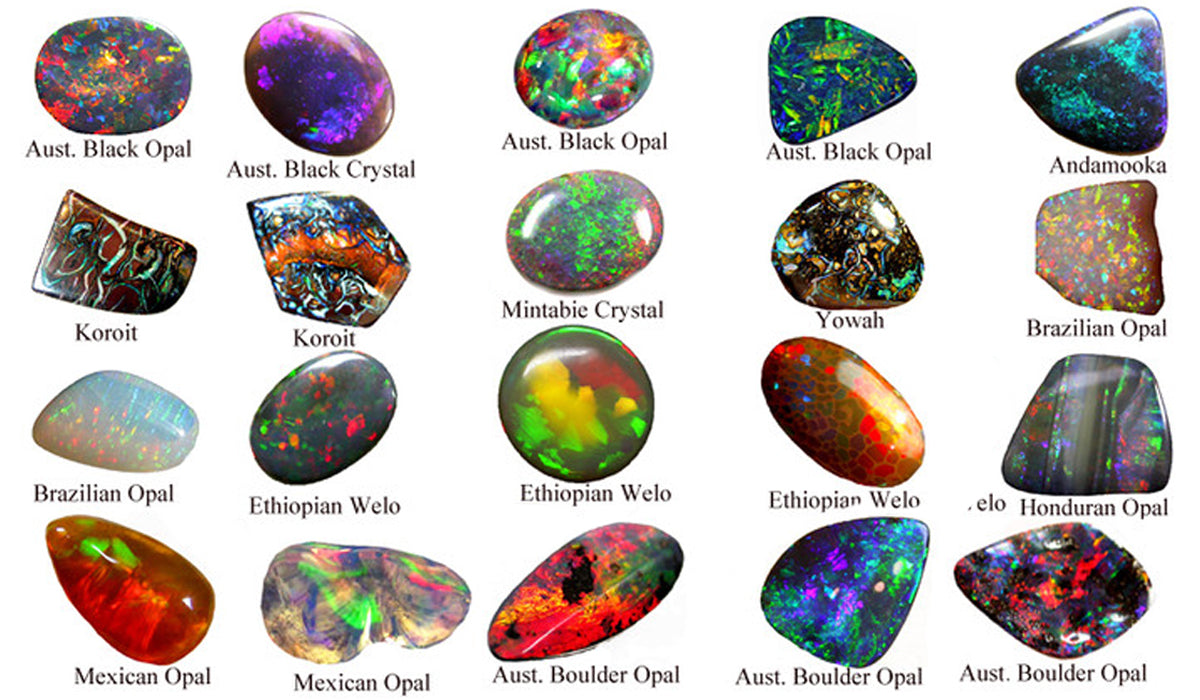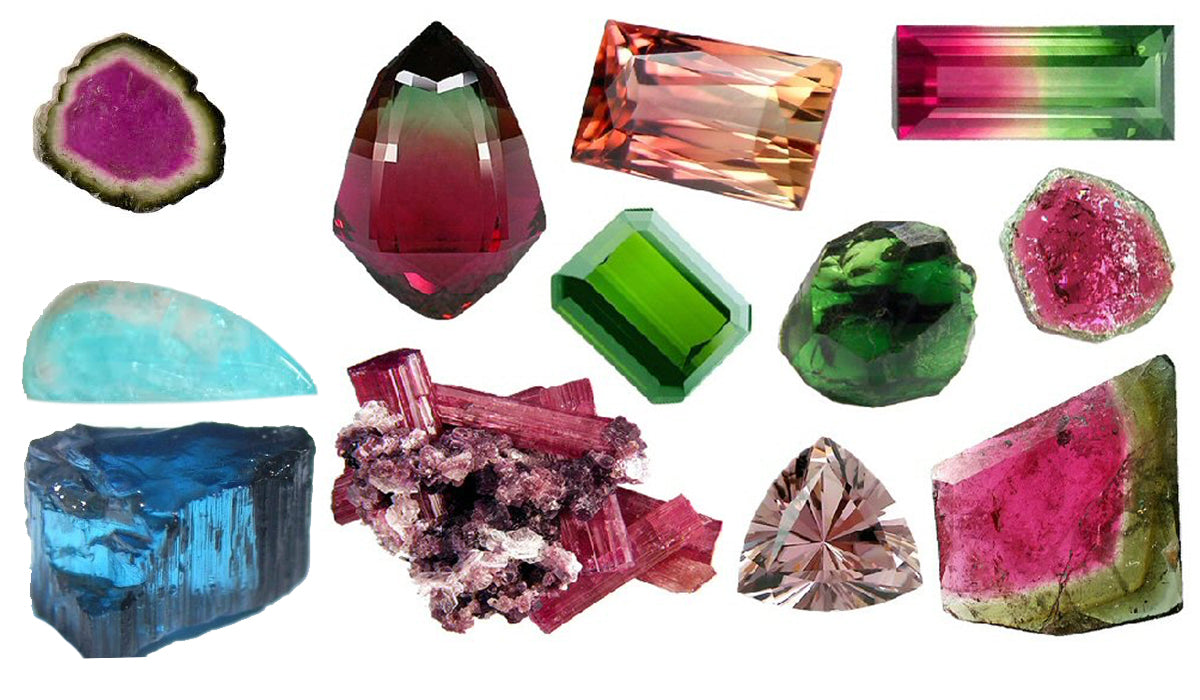OCTOBER - TWICE AS NICE

Us lucky October borns - ( yes, I am one of them) get to have two gorgeous gemstones for our birth month.
OPAL
Through the ages referred to as, ‘The tears of Zeus”, and believed by the Bedouins to be filled with Lightning, the kaleidoscopic play of colour trapped within opals has made them a source of fascination for centuries.
The word 'opal' is adapted from the Roman term opalus, but the origin of this word itself is a matter of debate. However, most modern references suggest it is adapted from the Sanskrit word "Upala” which literally translates to the word “jewel”. The argument for the Sanskrit origin is strong. The term first appears in Roman references around 250 BC, at a time when the opal was valued above all other gems. The word itself has two meanings, one is related to "seeing" and forms the basis of the English words like "opaque"; the other is "other" as in "alias" and "alter". It is claimed that opalus combined these uses, meaning "to see a change in colour".
Opals were formed when heavy seasonal rainfall drenched arid ground, seeping into the rocks below and drawing dissolved silica downwards. When the dry season returned, most of the water evaporated, leaving behind silica deposits in the cracks that would become opals.
There are many different categories of Opals as in all gemstones.
Precious Opal : any opal displaying play-of-color. This category includes white, black and boulder opal. Precious opal can be further distinguished by types:
- A single, solid piece of precious opal, having a uniform appearance and composition. This is the type of opal most commonly used for jewellery
- Precious opal that is attached to its host rock (a non-opal) in the form of a layer or seam. Boulder opal is an example of this. The opal is attached to a brown, iron-stained sandstone.
- Matrix opal occurs when precious opal fills cracks and openings in the host rock. The opal forms in pre-existing clay or sandstone. This material is frequently dyed.
- Doublets are slices of opal glued to a black backing, designed to imitate the appearance of a solid black opal.The black backing makes the thin slice of opal look that much darker and more vibrant. The backing is made of either black industrial glass, sometimes black potch (colourless opal) The thickness of the opal in a doublet can vary, however, it is generally thicker than the opal found in a triplet. The edges of the slice of opal are generally rounded off (if there is enough opal) to give the stone a cabochon cut.
- Triplets consist of three layers:A black backing as above paper-thin slice of opal in the middle with a clear glass, quartz, or plastic capping in the shape of a dome. The slice of opal in a triplet is usually extremely thin (paper-thin) so the clear capping serves to give the stone a nice cabochon on top. The clear capping may also magnify the colour of the opal slightly, and also serve to protect the opal.
Doublets & Triplets can usually be identified by looking at the side of the opal - the line where the opal and the backing meet, is perfectly straight. This is necessary for the layers to have adhered together. If these stones are set into jewellery with the sides covered, it is extremely difficult, even for an expert, to tell whether it is a doublet or a solid opal. Since doublets and triplets are generally more affordable than solid opals, they are very often used in gemstone jewellery.
▪ Common Opal : These are varieties of opal that do not show a play-of-color. Although they share the same chemical composition as precious opal, the silica spheres they contain are randomly arranged.
MINING
Australia’s rugged Outback provided the perfect geological spot for opals to form, and since it started producing them commercially in the 1890s, it has become one of the leading sources. Australia also produces rare black opals from underground mines at Lightning Ridge, which offer a magnificent play of colour. Black Australian opals with strong flashes of red are called Bushfire opals; so named as they resemble the burning embers of a bushfire.
Fiery colourings are what make Mexican opals, or Fire opals as they are also known, stand out. These red-orange gems get their colour from fine traces of iron oxide, and their warm glow is believed to promote feelings of courage and stamina. While many Fire opals found in Mexico do not have the play of colour that we associate with opals, when they do the result is positively volcanic.
Across the globe in Ethiopia, you can also find Fire opals, with flashes of neon red. Gems there can also display streaks of orange, green, yellow, brown and - most rare of all - blue. In 2008, a new stream of opal was found in Wegel Tena in Ethiopia’s Wollo Province, and these Welo opals are now the most sought-after of Ethiopia's opals adding that the brightness of the stones and the ethical mining practices used to unearth Welo opals are also a draw for the brand.
To take care of your Opals please clean them using warm soapy water and a soft brush.
You want to avoid ultrasonic cleaners and chemical cleaners.
TOURMALINE
Tourmaline has become a favourite gemstone among jewellery designer, and gem collectors the world over. Since it is available in a wide variety of colours, it is ideally suited to almost anyone's taste. Tourmaline also is known for displaying several colours in the same gemstone. These bi-color or tri-color gems are formed in many combinations; gemstones with clear colour distinctions are highly prized. One multi-color variety is known as watermelon tourmaline, and features green, pink, and white colours bands; to resemble its namesake, the gemstone is cut into thin slices having a pink centre, white ring, and green edge.
Tourmaline is found in many localities including Brazil, Afghanistan, East Africa, and the USA.
The California deposits are known for bright pinks, as well as colours. During the early 1900s, Maine and California were the world's largest producers of gem tourmalines. It is not clear when the first tourmaline was found in California,however, native Americans have used pink and green tourmaline as funeral gifts for centuries.
Almost every colour of tourmaline can be found in Brazil, but the most priceless of these is the paraiba tourmaline,which comes in a bluish green and has the vividness not seen in any other gemstone.
Another highly valuable variety is chrome tourmaline, from Tanzania which produces a green the colour of emeralds.
Pink and green Tourmalines from certain localities contain tiny, parallel inclusions that cause a strong cat's eye effect when polished - often cut into cabochons and named "Cats' eye tourmaline" . Some pink, green, and multicoloured Tourmalines are also carved into ornamental figures and carvings.
Tourmalines of all colours are faceted into gems for jewellery, but the red, green, blue, and multicoloured stones, especially watermelon, are the most popular. Tourmaline can be found in fairly large transparent crystals, and these can produce very large exquisite and flawless gemstones.
Both these gemstones have a beauty all of their own, and October borns are lucky to have that choice.